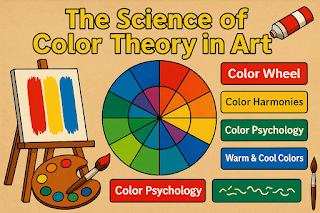The Science of Color Theory in Art: How Artists Use Color Psychology to Inspire Emotions and Meaning
Color isn't just seen—it’s felt. The way we respond to color shapes our perceptions, emotions, and even decisions. In the world of art, color theory forms the foundation of creative expression and emotional impact. Whether you're a budding artist, an art student, or a seasoned creative, understanding the science of color theory in art can take your work from good to truly compelling.
In this detailed guide, we'll dive deep into the scientific, psychological, and artistic aspects of color theory. Plus, you'll discover real-world applications, tools, and expert techniques to master color in your art. We’ve also included affiliate tools and product recommendations to help you explore color like a pro.
Table of Contents
- What Is Color Theory?
- The Science Behind Color
- The Color Wheel
- Color Harmonies and Relationships
- Color Psychology
- Warm vs. Cool Colors
- Color in Art Movements
- Cultural Interpretations of Color
- How Artists Use Color
- Best Digital Tools for Color Theory
- Common Color Mistakes
- How to Learn and Practice
- FAQs
- Conclusion
1. What Is Color Theory?
Color theory is both a science and an art. It is a set of principles used to understand and apply colors effectively. Developed over centuries, color theory helps artists create visual harmony, balance, and emotional response in their work.
2. The Science Behind Color: Physics and Perception
Light is made up of electromagnetic waves, and visible light is only a small portion of the spectrum. When light hits an object, some wavelengths are absorbed, while others are reflected. The reflected light is what we see as color.
- Red has longer wavelengths.
- Blue and violet have shorter wavelengths.
Color is also psychological—it’s interpreted by our brain based on context, environment, and memory.
3. The Color Wheel: Primary, Secondary & Tertiary Colors
🎨 Primary Colors:
- Red
- Blue
- Yellow
🎨 Secondary Colors:
- Green = Blue + Yellow
- Orange = Red + Yellow
- Purple = Red + Blue
🎨 Tertiary Colors:
Red-orange, yellow-green, blue-violet, etc.
4. Color Harmonies and Relationships
- Complementary: Opposites on the wheel (e.g., red and green)
- Analogous: Adjacent colors (e.g., blue, blue-green, green)
- Triadic: Equally spaced (e.g., red, yellow, blue)
- Split-complementary: One base and two neighbors of its complement
5. Color Psychology: How Colors Affect Emotion
- Red: Passion, energy
- Blue: Trust, calm
- Yellow: Happiness, youth
- Green: Growth, health
- Purple: Royalty, creativity
- Black: Power, mystery
- White: Purity, simplicity
6. Warm vs. Cool Colors
Warm: Red, orange, yellow (energizing)
Cool: Blue, green, purple (calming)
7. Color in Different Art Movements
- Impressionism: Light and natural color
- Fauvism: Unnatural, vibrant colors
- Cubism: Limited, monochromatic schemes
- Pop Art: Bright, bold, commercial colors
8. Cultural Interpretations of Color
- White: Western - purity; Asian - mourning
- Red: Western - love; Eastern - celebration
9. How Artists Use Color Theory Practically
- Mood and atmosphere
- Focal points using contrast
- Creating depth with warm/cool color contrast
10. Best Digital Tools for Color Theory
- 🎨 Pantone Formula Guide
- 🎨 Color Muse Scanner
- 🎨 Wacom Intuos Graphics Tablet
- 🎨 Faber-Castell Color Wheel
11. Common Color Mistakes to Avoid
- Too much saturation
- Poor contrast
- Ignoring lighting and context
12. How to Learn and Practice Color Theory
- Online platforms: Skillshare, Coursera
- Read: “Interaction of Color” by Josef Albers
- Use color wheel tools
- Recreate master artworks
14. Frequently Asked Questions (FAQ)
What is color theory in art?
Color theory is the study of how colors interact, their emotional effects, and how artists can use them to create visual harmony and meaning.
Why is color theory important?
It helps artists choose effective color combinations that enhance storytelling, emotional impact, and visual balance.
How do I start learning color theory?
Start with a color wheel, study famous artworks, use tools like Adobe Color, and take beginner-friendly online classes.
15. Final Thoughts
Understanding the science of color theory is essential to becoming a confident and expressive artist. Whether you're working in oils, digital media, or mixed techniques, mastering color will amplify your creativity and help you build an emotional connection with your audience.
Let your art speak in color—because color is the universal language of emotion.
🧩 What's Next?
If you found this helpful:
- Share
it on WhatsApp or social media
- Subscribe
to our newsletter
- Comment
below: What’s your favorite color?
📢 Affiliate Disclaimer
This post contains affiliate links. If you purchase through
these links, I may earn a small commission at no extra cost to you. This helps
support the blog and allows me to create more helpful content for you. Thank
you


Post a Comment